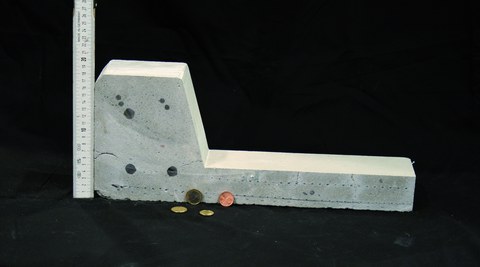Oberflächenfertige, vollkomplettierte, textilbewehrte Balkonbodenplatten mit integrierter Tragelemente-Anbindung
Inhaltsverzeichnis
Projektdaten
|
Titel | Title |
Bericht aus dem Jahrbuch 2011
Leichte Balkonplatte aus Textilbeton

Schlanker Anschluss zwischen textilbewehrter Platte und stahlbewehrtem Randbalken
Im Rahmen einer durch die Arbeitsgemeinschaft industrieller Forschungsvereinigungen „Otto von Guericke“ (AiF) geförderten Industriekooperation wurde die Eignung von Textilbeton für die Herstellung von leichten, materialeffizienten Balkonbodenplatten untersucht. Es konnte erfolgreich nachgewiesen werden, dass im Vergleich zu der herkömmlichen Ausführung in Stahlbeton die Platten filigraner und leichter sein können. Besondere Herausforderung des Projektes war es, eine geeignete Herstelltechnologie für eine industrielle und wirtschaftliche Massenfertigung zu finden. Es wurden zudem Berechnungs- und Bemessungsverfahren für die erforderlichen Nachweise der Tragfähigkeit und Gebrauchstauglichkeit entwickelt.
Als Ergebnis der theoretischen Betrachtungen und fünf experimentell untersuchten Prototypen steht den Praxispartnern eine funktionstüchtige, vierpunktgelagerte Balkonplatte mit einer Grundfläche von 3,75 × 1,75 m und einem umlaufenden Randbalken, ausgebildet als Oberzug, zur Kundenpräsentation zur Verfügung. Als Bewehrung kamen verschiedene Materialien wie Baustahl BSt 500, BSt 500 NR und Carbontextil SIGRATEX Grid 600 (SGL Technologies GmbH) zum Einsatz. Diese Bewehrungsmaterialien wurden entsprechend ihrer optimalen Eignung den Bauteilbereichen zugeordnet – BSt 500 dem (massiven) Randbalken, die Carbonbewehrung dem filigranen Plattenspiegel und der Edelstahl im Übergangsbereich Platte-Randbalken. An der Oberseite wurde außerdem eine Nutzschicht aus Prägebeton angeordnet. Mit einer Plattenspiegeldicke von lediglich 4,5 bis 11 cm konnte eine sehr filigrane, leichte Struktur konstruiert werden. Die Herstellung erfolgte im Betonwerk in einem kombinierten Verfahren aus Fließbetonage und Laminieren.
Die kontinuierliche Verbesserung der Konstruktion während der Prototypenentwicklung führte zur Minimierung des Fertigungsaufwandes und der Herstellkosten. Die abschließende Wirtschaftlichkeitsbetrachtung zeigte, dass unter Ausnutzung weiterer noch nicht berücksichtigter Optimierungsmöglichkeiten die entwickelte Textilbetonplatte mit einer gleichwertig tragfähigen Stahlbetonplatte konkurrieren kann.
